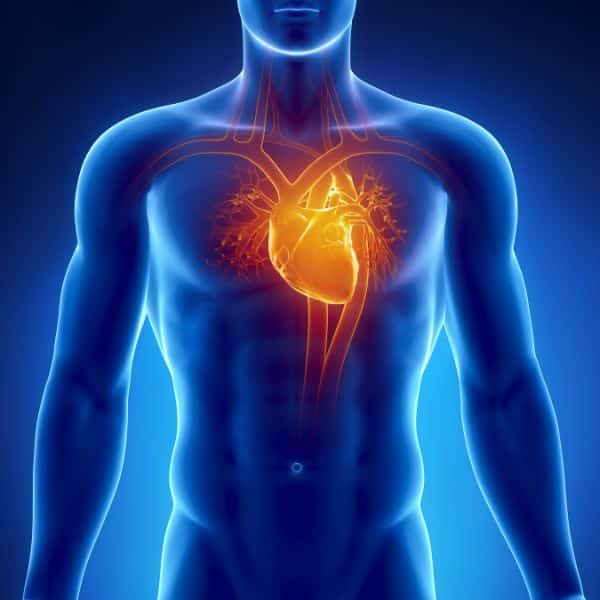The right ventricle pumps blood to the lungs.

The right ventricle pumps oxygen-poor blood to the lungs for oxygenation.
The heart is located on the right side of the body.

The heart is located in the middle of the chest, slightly to the left side.
The heart has four major blood vessels.

- Aorta: Carries oxygen-rich blood from the left ventricle to the rest of the body.
- Pulmonary Artery: Carries oxygen-poor blood from the right ventricle to the lungs.
- Pulmonary Veins: Carry oxygen-rich blood from the lungs to the left atrium.
- Superior and Inferior Vena Cava: Carry oxygen-poor blood from the body to the right atrium.
Blood pressure has a daily pattern. It usually starts to rise before waking up and peaks around noon. Then drops back down in the evening.

Blood pressure does follow a daily pattern, known as circadian rhythm.
- Rises Before Waking: Blood pressure typically starts to increase in the early morning hours, before you wake up, due to hormonal changes and the body preparing for activity.
- Peaks Around Noon: It usually reaches its highest levels during the mid-morning to early afternoon, as daily activities and stress levels increase.
- Drops in the Evening: Blood pressure gradually decreases in the late afternoon and evening, reaching its lowest point during sleep when the body is at rest.
The heart pumps more blood per minute when we are exercising.

- During exercise, muscles work harder and need more oxygen and energy.
- The heart responds by beating faster (increased heart rate) and pumping more forcefully (increased stroke volume).
- This increases the total amount of blood pumped per minute, known as cardiac output.
Blood pressure in the range of 120/80 - 129/80 is considered stage 1 hypertension.

120-129/less than 80 is considered elevated blood pressure-NOT stage 1 hypertension.
Advertisement
The heart can repair itself if it is damaged.

- Heart Muscle Cells: Most heart muscle cells (cardiomyocytes) cannot divide or regenerate significantly after damage, unlike some other cells in the body.
- Scar Tissue: When the heart is damaged (e.g., from a heart attack), the damaged area often forms scar tissue, which cannot contract or pump blood like healthy heart muscle.
- Limited Regeneration: While some research suggests the heart might have a tiny ability to regenerate, it’s not enough to fully repair significant damage.
The human heart has four chambers.

The human heart has four chambers: two atria (upper chambers) and two ventricles (lower chambers). The right atrium receives oxygen-poor blood from the body and pumps it to the right ventricle, which then sends it to the lungs to pick up oxygen. The left atrium receives oxygen-rich blood from the lungs and pumps it to the left ventricle, which then pumps it out to the rest of the body. This four-chambered structure allows the heart to efficiently separate oxygenated and deoxygenated blood, ensuring proper circulation.
The sinoatrial (SA) node is the pacemaker of the heart.

The sinoatrial (SA) node is indeed the pacemaker of the heart. Here's a simple explanation: The SA node is a small group of cells located in the right atrium of the heart. It generates electrical impulses that start each heartbeat. These impulses spread through the atria, causing them to contract and pump blood into the ventricles. The SA node sets the rhythm and pace of the heart, which is why it’s called the "pacemaker." Without the SA node, the heart wouldn’t beat in a coordinated way.
The right atrium receives oxygen-rich blood from the lungs.

The right atrium receives oxygen-poor blood from the body, not oxygen-rich blood from the lungs. The left atrium receives oxygen-rich blood from the lungs.
The left ventricle pumps blood to the body.

The left ventricle pumps oxygen-rich blood to the body through the aorta.
High blood pressure can damage the heart.

- Increased Workload: High blood pressure forces the heart to work harder to pump blood, which can lead to thickening of the heart muscle (left ventricular hypertrophy).
- Reduced Efficiency: Over time, the thickened heart muscle can become stiff and less efficient at pumping blood.
- Risk of Disease: High blood pressure increases the risk of heart diseases, such as coronary artery disease, heart failure, and heart attacks.
Advertisement
According to research, a magnesium deficiency, or restricted intake, increases irregular heartbeats known as arrhythmias.

Research indicates that magnesium plays a crucial role in maintaining normal heart rhythm. A deficiency in magnesium, or restricted intake, can lead to an imbalance in electrolytes, which are essential for proper electrical activity in the heart. This imbalance can increase the risk of irregular heartbeats, known as arrhythmias. Magnesium helps regulate the movement of calcium and potassium ions in and out of heart cells, which is vital for maintaining a steady heartbeat. Therefore, ensuring adequate magnesium levels is important for cardiovascular health.
The heart is protected by the ribcage.

The heart is protected by the ribcage and the breastbone.
The heart has its own electrical conduction system.

The heart has its own electrical conduction system that controls the heartbeat.
- Sinoatrial (SA) Node: Known as the heart's natural pacemaker, it generates electrical impulses that start each heartbeat.
- Atrioventricular (AV) Node: Receives the electrical signal from the SA node and delays it slightly to allow the atria to contract and fill the ventricles with blood.
- Bundle of His and Purkinje Fibers: These pathways spread the electrical signal to the ventricles, causing them to contract and pump blood out of the heart.




